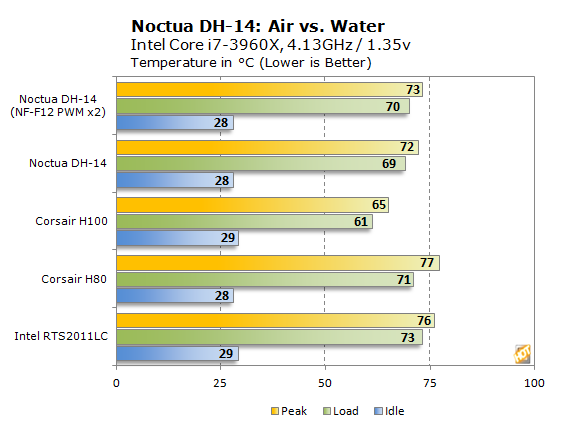Noctua's DH-14: Air Cooling Keeps Up With Liquid?
Overclocking, Noise Levels
|

At 4.13GHz, the DH-14 is actually better than both the H80 and Intel coolers. The H100 remains ~7C cooler, but Noctua's air cooler can clearly keep up. Our 4.5GHz test raises the CPU voltage still further, but increases fan speeds to compensate.

Higher fan speeds bring the H80's temperatures back in line with the DH-14, while the H100 retains a consistent advantage. Both OC tests show a small advantage for the default fans, though this could be small variations in ambient temperature.
Noise Levels:
We didn't have measuring equipment precise enough for a qualitative comparison of dB levels, which would give you an idea how quiet all of these solutions are to begin with. With that said, there are some qualitative points we can discuss.
At stock speeds, the fans on the liquid coolers, and on the Noctua DH-14, are all inaudible. We use that word for a reason--unlike "silent," which is often modified with unclear words like "virtually," something is either audible or it isn't. Standing in a room with no external fan noise, central air/heat, TV, or music, you can't hear any of the fans. What you can hear are the liquid coolers' pumps. Not much--but in the rareified air of $90 coolers, people care about those tiny differences.
At 4.5GHz, the H100 is quieter than the DH-14 or the H80—but it's also significantly more expensive.
As for Noctua's NF-P12 fans, their chief advantage over the stock options is that they have a PWM to allow for dynamic, on-the-fly adjustments. That's not a knock against them--the idea of paying $89 for a cooler with substandard stock fans is a much greater turn-off than the fact that they don't improve the already-excellent performance of the DH-14. In point of fact, it'd be difficult for any high-end cooler to improve on what the DH-14 offers—it's really just that good.






